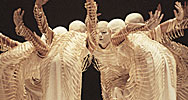 Lines Migrates Two Steps Forward, One Downward Facing Dog Back
Lines Migrates Two Steps Forward, One Downward Facing Dog Back Lines Ballet
November 4, 2006
Fall Home Season
Migrations and Sky Clad
I have a secret to admit, and it’s no small one. Sure, I don’t have a secret baby girl who I’ve shuttled off to Alaska to live in the wild raised by grizzly bears. And no, I do not have a secret shrine complete with disco ball devoted to the ever-changing dance styles of Madonna. But what’s true is that I’ve lived in San Francisco for over five years, and hadn’t seen Lines Ballet in performance until this past weekend. That’s right. Yours truly was an Alonzo King newbie. Thankfully, though, I wasn’t a dance newbie. Otherwise, I’d think the evening’s theme was boyshorts (seemingly the preferred costume choice for King’s men).
The program’s highlight proved to be King’s stateside premiere of Migration: The Hierarchical Migration of Birds and Mammals, set to music by Pharoah Sanders, Miguel Frasconi, and Leslie Stuck. The nine dancers began their migration by taking flight (or perhaps hatching out of their shells) on the floor, arching their backs and gracefully flailing their limbs. In fact, there was a lot of graceful flailing throughout, but coupled with sweeping lifts, circular hip swivels, and quick parallel passé sautés, it took on a more gratifying importance, one of upward movement, forward thinking, and ascension.
King’s duet for Meredith Webster and Brett Conway spanned more towards the “mammals” migration. With long extensions, intricate yet striking partnering, and a tenderness not seen in traditional ballet, Webster and Conway showcased a more animalistic edge, one that appeared more grounded and earthy instead of the airiness seen in the other bird-like section.
King’s San Francisco premiere of Sky Clad didn’t make a splash (perhaps like a sea lion or some other marine mammal) like Migration did. While the live music of Hindustani vocalist Rita Sahai with accompaniment by Rachel Unterseher (violin/viola) and Debopriyo Sarkar (tabla) sounded inspiring, the musicians were situated in the pit facing the dancers, and it was difficult to even see them. Had I not known they were there, I probably wouldn’t have even realized the music was live. Perhaps situating them at a better angle on the side of the pit could play up the live factor a tad bit.
The loss of “live music” effect wasn’t the only aspect that fell flat. King’s movement, compared to that of Migration, felt superficial, incorporating some of his choreographic trademarks such as flowing spins, jutting hips, and fully extended grand battements with a slew of yoga and traditional Indian poses. That’s right, downward facing dog and eagle pose combined with ballet and contemporary dance don’t quite mix. The dancers, though, saved Sky Clad from migrating too far down the food chain, and they committed to the movement with attack and grace.
Migration has potential, and I’m glad I’ve finally added Lines’ to my repertoire. Plus, King’s dancers impressed me with their technical feats (and feet) and artistic abilities, and I look forward to seeing the company migrate onward.
Photo by Thomas Ammerpohl

